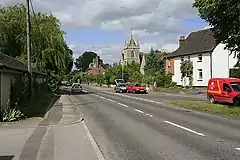Winterbourne Earls
Winterbourne Earls is a village in Wiltshire, England. The village is in the Bourne valley on the A338 road, about 3.4 miles (5 km) northeast of Salisbury.
| Winterbourne Earls | |
|---|---|
 A338, Winterbourne Earls | |
| Civil parish | |
| Unitary authority | |
| Ceremonial county | |
| Region | |
| Country | England |
| Sovereign state | United Kingdom |
| Post town | Salisbury |
| Postcode district | SP4 |
| Dialling code | 01980 |
| Police | Wiltshire |
| Fire | Dorset and Wiltshire |
| Ambulance | South Western |
| UK Parliament | |
| Website | The Winterbournes |
The village adjoins Winterbourne Dauntsey. It is part of the civil parish of Winterbourne, formed in 1934 by amalgamating the three ancient parishes of Winterbourne Earls, Winterbourne Dauntsey and Winterbourne Gunner.[1]
History
The name "Earls" came from the Earls of Salisbury who were Lords of the Manor in the thirteenth century. Since then, the parish of Winterbourne Earls has only changed hands twice; in 1551 it was leased to the Nicholas family, by its owners, the Bishops of Salisbury, then in 1799, the Fort family took the lease, and remained at the property until the mid-twentieth century.[1]
Churches
A Wesleyan Methodist chapel was built in 1843 at Hurdcott, immediately to the south of Winterbourne Earls.[2] The chapel closed in 1967 and the community is served by Bourne Valley Methodist Church at Winterbourne Dauntsey.
The Church of England parish church of St Michael and All Angels serves the village and Winterbourne Dauntsey.[3] It was built in 1867-8 by T.H. Wyatt and replaced an older church, probably built in the 12th century.[4] The church is Grade II listed.[5]
Facilities
Winterbourne Earls CofE Primary School serves the village and surrounding communities.[6] The school was built in 1992 on a new site to replace a National School dating from 1872.[7]
There is a pub at Hurdcott (the Black Horse) and another at Winterbourne Dauntsey (the Winterbourne Arms).[8]
Notable people
Henry Sherfield (c.1572-1634, lawyer and Member of Parliament) lived in the village,[9] and Matthew Nicholas (1594-1661, Dean of St Paul's Cathedral) was buried at Winterbourne Earls.[10]
References
- "Winterbourne". Wiltshire Community History. Wiltshire Council. Retrieved 3 September 2016.
- "Methodist Chapel, Hurdcott, Winterbourne Earls". Wiltshire Community History. Wiltshire Council. Retrieved 26 July 2015.
- "St Michael & All Angels, Winterbourne Earls". Bourne Valley Churches. Retrieved 26 July 2015.
- "Old Church of St. Michael, Winterbourne Earls". Wiltshire Community History. Wiltshire Council. Retrieved 26 July 2015.
- Historic England. "Church of St Michael and All Angels, Winterbourne Earls (1135725)". National Heritage List for England. Retrieved 25 July 2015.
- "Winterbourne Earls Church of England Primary School". Retrieved 25 July 2015.
- "Winterbourne Earls C. of E. Primary School". Wiltshire Community History. Wiltshire Council. Retrieved 26 July 2015.
- "The Winterbourne Arms". Retrieved 3 September 2015.
- Ralph Bernard Pugh (1953). The Victoria History of Wiltshire. University of London, Institute of Historical Research.
- Christopher Wordsworth; George Herbert Moberly (1902). The fifteenth century cartulary of St. Nicholas' hospital. Brown & co.
External links
![]() Media related to Winterbourne Earls at Wikimedia Commons
Media related to Winterbourne Earls at Wikimedia Commons
- The Winterbournes parish website